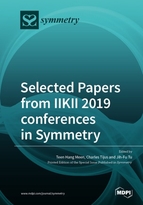Selected Papers from IIKII 2019 conferences in Symmetry
A special issue of Symmetry (ISSN 2073-8994).
Deadline for manuscript submissions: closed (31 January 2020) | Viewed by 74449
Special Issue Editors
Interests: IOT devices; photovoltaic devices; STEM education
Special Issues, Collections and Topics in MDPI journals
Interests: internet of objects; data mining; brain–computer interaction
Special Issues, Collections and Topics in MDPI journals
Interests: human–computer interaction; internet technologies; distributed processing systems
Special Issues, Collections and Topics in MDPI journals
Special Issue Information
Dear Colleagues,
Symmetry in language refers to a sense of harmonious and beautiful proportion and balance. In mathematics, "symmetry" has a more precise definition, that an object is invariant to any of various transformations; including reflection, rotation or scaling. Mathematical symmetry may be observed with respect to the passage of time; as a spatial relationship; through geometric transformations; through other kinds of functional transformations; and as an aspect of abstract objects, theoretic models and even knowledge itself. Recently, Symmetry theorem and simulation are widely applied engineering to improve the developments of new technologies.
In addition, International Institute of Knowledge Innovation and Invention (IIKII, http://www.iikii.org) is the institute to promote the exchange of innovations and inventions, and establishes a communication platform for international innovations and researches. In this year, IIKII cooperates with IEEE Tainan Section Sensors Council to hold IEEE conferences such as IEEE ICIASE 2019 (http://2019.iciase.net), IEEE ECBIOS 2019 (http://2019.ecbios.asia), IEEE ICKII 2019 (http://2019.ickii.org), ICUSA-GAME 2019 (http://www.icusa2019.org), and IEEE ECICE 2019 (http://2019.ecice.asia). This Special Issue entitled "Selected Papers from IIKII 2019 conferences" aims to select excellent papers from IIKII 2019 conferences, including symmetry in physics, chemistry, biology, mathematics, and computer science, etc. We invite investigators to contribute original research articles, as well as review articles, to this special issue. Potential topics include, but are not limited to:
- Physics: conservation laws, Noether's theorem, spatial parity, charge parity, time parity, G-parity, standard model, internal symmetry, Lorentz symmetry, transformations, invariance, conservation, local and global symmetries, laws and symmetry, symmetry breaking, color symmetry, periodic and quasiperiodic crystals, time-reversal symmetry breaking, symmetry and complexity, Curie-Rosen symmetry principles, constants, biophysics, entropy, and indistinguishability.
- Chemistry: crystal and crystallography; chiral molecules, chiral resolution and asymmetric synthesis, asymmetric induction, chiral auxiliaries and chiral catalysts, stereochemistry, diastereomers, stereogenic, stereoisomers (enantiomers, atropisomers, diastereomers), stability, mixing, and phase separation.
- Biology:symmetry in biology, radial symmetry (tetramerism, pentamerism, etc.), diversity, preservation, sustainability, morphology, origin of life, and molecular evolution (homochirality).
- Mathematics: invariance, transformation, group theory, Lie groups, chirality, achiral or amphichiral, helix and Möbius strip, knot theory, graph theory, isometry, plane of symmetry, skewness, vertex algebra, asymmetry, dissymmetry, nonsymmetry and antisymmetry, supergroups and nonlinear algebraic structures, supersymmetry and supergravity, strings and branes, integrability and geometry, information theory, Felix Klein's Erlangen Program, and continuous symmetry.
- Computer Science, Theory and Methods:computer-aided design, computational geometry, computer graphics, visualization, image compression, data compression, pattern recognition, diversity, similarity, and conservation and sustainability.
- Symmetry and other scientific disciplines and engineering.
-
Schedule
Manuscript Due: December 31, 2019
First Round of Reviews: January 31, 2020
Second Round of Reviews: February 29, 2020
Acceptance of Final papers and Publication: March 31, 2020
Prof. Dr. TeenHang Meen
Prof. Dr. Charles Tijus
Prof. Dr. Jih-Fu Tu
Guest Editors
Manuscript Submission Information
Manuscripts should be submitted online at www.mdpi.com by registering and logging in to this website. Once you are registered, click here to go to the submission form. Manuscripts can be submitted until the deadline. All submissions that pass pre-check are peer-reviewed. Accepted papers will be published continuously in the journal (as soon as accepted) and will be listed together on the special issue website. Research articles, review articles as well as short communications are invited. For planned papers, a title and short abstract (about 100 words) can be sent to the Editorial Office for announcement on this website.
Submitted manuscripts should not have been published previously, nor be under consideration for publication elsewhere (except conference proceedings papers). All manuscripts are thoroughly refereed through a single-blind peer-review process. A guide for authors and other relevant information for submission of manuscripts is available on the Instructions for Authors page. Symmetry is an international peer-reviewed open access monthly journal published by MDPI.
Please visit the Instructions for Authors page before submitting a manuscript. The Article Processing Charge (APC) for publication in this open access journal is 2400 CHF (Swiss Francs). Submitted papers should be well formatted and use good English. Authors may use MDPI's English editing service prior to publication or during author revisions.
Keywords
- Physics symmetry
- Chemistry symmetry
- Biology symmetry
- Mathematics symmetry, Computer Science, Theory and Methods
- Symmetry and other scientific disciplines and engineering








